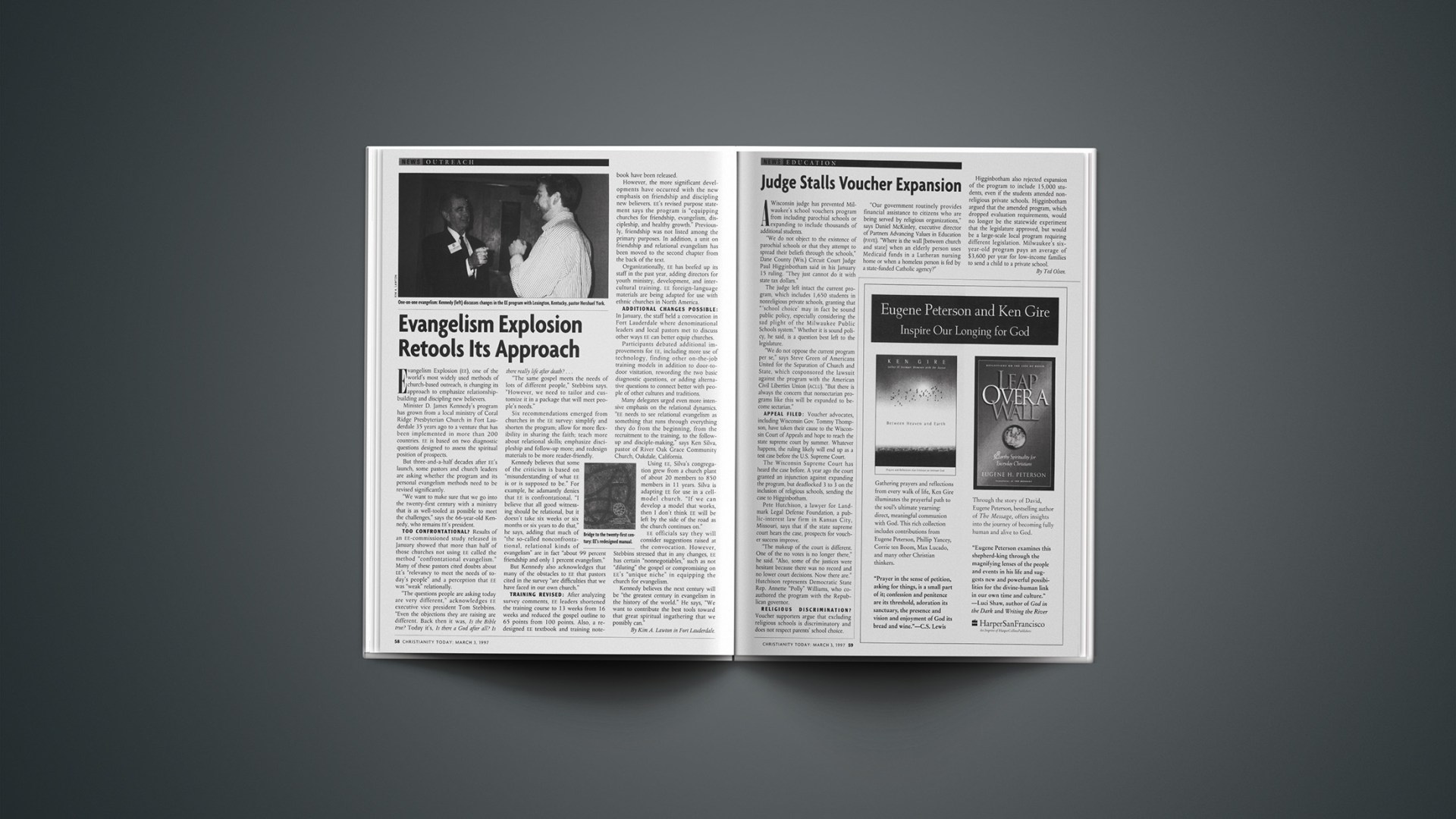Evangelism Explosion (EE), one of the world’s most widely used methods of church-based outreach, is changing its approach to emphasize relationship-building and discipling new believers.
Minister D. James Kennedy’s program has grown from a local ministry of Coral Ridge Presbyterian Church in Fort Lauderdale 35 years ago to a venture that has been implemented in more than 200 countries. EE is based on two diagnostic questions designed to assess the spiritual position of prospects.
But three-and-a-half decades after EE’s launch, some pastors and church leaders are asking whether the program and its personal evangelism methods need to be revised significantly.
“We want to make sure that we go into the twenty-first century with a ministry that is as well-tooled as possible to meet the challenges,” says the 66-year-old Kennedy, who remains EE’s president.
TOO CONFRONTATIONAL? Results of an EE-commissioned study released in January showed that more than half of those churches not using ee called the method “confrontational evangelism.” Many of these pastors cited doubts about ee’s “relevancy to meet the needs of today’s people” and a perception that EE was “weak” relationally.
“The questions people are asking today are very different,” acknowledges EE executive vice president Tom Stebbins. “Even the objections they are raising are different. Back then it was, Is the Bible true? Today it’s, Is there a God after all? Is there really life after death? …
“The same gospel meets the needs of lots of different people,” Stebbins says. “However, we need to tailor and customize it in a package that will meet people’s needs.”
Six recommendations emerged from churches in the EE survey: simplify and shorten the program; allow for more flexibility in sharing the faith; teach more about relational skills; emphasize discipleship and follow-up more; and redesign materials to be more reader-friendly.
Kennedy believes that some of the criticism is based on “misunderstanding of what EE is or is supposed to be.” For example, he adamantly denies that EE is confrontational. “I believe that all good witnessing should be relational, but it doesn’t take six weeks or six months or six years to do that,” he says, adding that much of “the so-called nonconfrontational, relational kinds of evangelism” are in fact “about 99 percent friendship and only 1 percent evangelism.”
But Kennedy also acknowledges that many of the obstacles to EE that pastors cited in the survey “are difficulties that we have faced in our own church.”
TRAINING REVISED: After analyzing survey comments, EE leaders shortened the training course to 13 weeks from 16 weeks and reduced the gospel outline to 65 points from 100 points. Also, a redesigned EE textbook and training notebook have been released.
However, the more significant developments have occurred with the new emphasis on friendship and discipling new believers. EE’s revised purpose statement says the program is “equipping churches for friendship, evangelism, discipleship, and healthy growth.” Previously, friendship was not listed among the primary purposes. In addition, a unit on friendship and relational evangelism has been moved to the second chapter from the back of the text.
Organizationally, EE has beefed up its staff in the past year, adding directors for youth ministry, development, and intercultural training. EE foreign-language materials are being adapted for use with ethnic churches in North America.
ADDITIONAL CHANGES POSSIBLE: In January, the staff held a convocation in Fort Lauderdale where denominational leaders and local pastors met to discuss other ways EE can better equip churches.
Participants debated additional improvements for EE, including more use of technology, finding other on-the-job training models in addition to door-to-door visitation, rewording the two basic diagnostic questions, or adding alternative questions to connect better with people of other cultures and traditions.
Many delegates urged even more intensive emphasis on the relational dynamics. “EE needs to see relational evangelism as something that runs through everything they do from the beginning, from the recruitment to the training, to the follow-up and disciple-making,” says Ken Silva, pastor of River Oak Grace Community Church, Oakdale, California.
Using EE, Silva’s congregation grew from a church plant of about 20 members to 850 members in 11 years. Silva is adapting EE for use in a cell-model church. “If we can develop a model that works, then I don’t think EE will be left by the side of the road as the church continues on.”
EE officials say they will consider suggestions raised at the convocation. However, Stebbins stressed that in any changes, EE has certain “nonnegotiables,” such as not “diluting” the gospel or compromising on EE’s “unique niche” in equipping the church for evangelism.
Kennedy believes the next century will be “the greatest century in evangelism in the history of the world.” He says, “We want to contribute the best tools toward that great spiritual ingathering that we possibly can.”
Copyright © 1997 Christianity Today. Click for reprint information.









